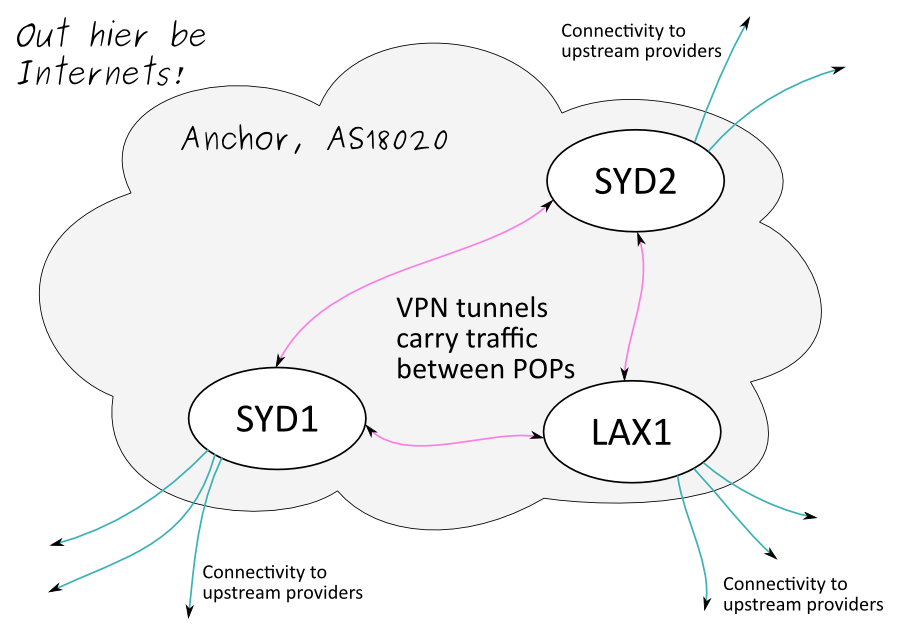Contents
If shit is really broken
You should contact the NOC team.
High-level diagram

POPs
Anchor maintains a few points of presence (POP), one of which is our headquarters in the Sydney CBD.
Address space
IP v4
IP v6
2407:7800::/32 » Details
Autonomous System
Anchor has an AS number, it's 18020. This is used for our BGP routing and lets us get on the interwebs.
Routing
The basics:
We have a few POPs inside the "Anchor cloud" (our Autonomous System)
OSPF gets traffic between POPs
BGP gets traffic in and out of the Anchor cloud
Dynamic routing is all about advertising your presence - rather than setting up static routes on every system, you advertise yourself and other systems will figure out how to reach you
Why we need to route
Anchor has multiple connections to the outside world at each POP for redundancy. If a connection fails (eg. backhoe causality incident) we still have connectivity. Routing protocols handle the failover for us, resulting in a minimum of downtime.
Routing also gives us some flexibility in addressing, as we can advertise chucks of address space from each POP where it's in use.
How we make use of BGP
BGP is primarily an exterior routing protocol, between autonomous systems. BGP is also often used inside an AS so that border routers can have a consistent picture of connectivity to the outside world. When used in this way it's called IBGP (Interior or Internal BGP).
Exterior routing
The border routers at each POP advertise part of Anchor's address space to the internet, via our upstream providers at each POP. The border routers are referred to as "BGP speakers", and BGP is spoken along the cyan-coloured links in the diagram above.
The working behind this is roughly » as follows
Note that a given chunk of address space (eg. a /24) can be advertised from multiple POPs. This is not a problem, so long as traffic can be correctly routed to its destination once it's inside the AS.
Internal routing
We already have an interior routing protocol (OSPF), so why do we need to use BGP internally as well? We run IBGP in a limited fashion within our AS, it basically gives border routers options for egressing the AS.
At the time of writing, IBGP is used almost exclusively within each POP, and is not represented on the diagram above.
A non-representative scenario
This is a generic example of why IBGP is useful. We do not use IBGP » like this though.
A realistic scenario
We use IBGP between the border routers at each POP. Consider the » following example
How we make use of OSPF
We use OSPF to get packets between POPs. The alternative is to maintain static routes at each POP, which has substantial management overheads and would be error-prone.
Between POPs
OSPF routers are always "adjacent" to each other. In an ideal world this would be a direct fibre connection. The harsh reality is that we use VPN tunnels between POPs, as described in the next section. These are the pink-coloured links in the diagram above.
Within a POP
At the time of writing, we're not doing this but it's on the cards for the future.
FIXME: finish this next
Advertising subnets "up" to our border routers.
Use of routing at each POP

Inter-POP connectivity
We use tunnels to carry inter-POP traffic. This is fantastic because it allows our privately-addressed networks (RFC1918) to be accessed from anywhere in the Anchor network. On the downside, it means we need to be careful when allocating new privately-addressed networks.
We use OpenVPN and IPsec tunnels depending on the available networking infrastructure at each POP. Use of OSPF between POPs means we can run a full mesh of tunnels if we want to, and everything should keep working in the event of failures.
Addressing policy
Private addressing is a bit of a mess
https://map.engineroom.anchor.net.au/BackupNetworkAddressingPolicy
Edumacation
Fukken <x> how does it work!?
Per-POP stuff
We should develop a template for all the information you expect to find for each POP. Structure will be something like /PoP/$popname/foo
Connectivity (upstream providers)
Physical environment
Backdoor access
Network infrastructure (hardware, how it's deployed, what software it runs, local network architecture)
Naming policy (eg. VLANs in FQDNs)
Local addressing policy? Don't duplicate anything from the global scope
Access and delivery arrangements
Local routing policies (eg. BGP path prefixes, any funky processing that we do)
Provisioning procedures
Resource allocations (power, network ports)
Troubleshooting? Ideally shouldn't be POP-specific